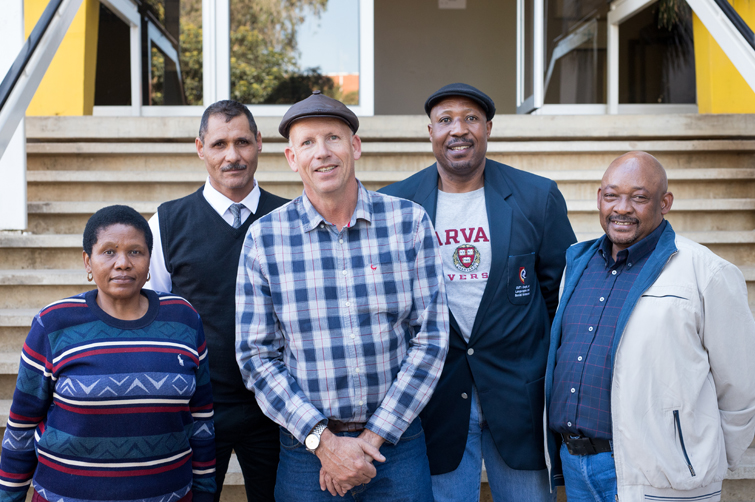Latest News Archive
Please select Category, Year, and then Month to display items
13 January 2020
|
Story Eugene Seegers
|
Photo Anja Aucamp
 Spearheading the digital expansion of the conversational Sesotho course is IDEAS Lab Director, Johann Möller (middle). With him are from the left: Prof Pule Phindane, CUT; Dr Brenton Fredericks, CUT; Bahedile Letlala, UFS Department of African Languages; and Dr Elias Malete, UFS Department of African Languages.
Spearheading the digital expansion of the conversational Sesotho course is IDEAS Lab Director, Johann Möller (middle). With him are from the left: Prof Pule Phindane, CUT; Dr Brenton Fredericks, CUT; Bahedile Letlala, UFS Department of African Languages; and Dr Elias Malete, UFS Department of African Languages.
For many years now, the UFS has been offering a one-year course in conversational Sesotho for staff members; this can then be followed up with the one-year course in advanced conversational Sesotho. The conversational Sesotho for students in the Faculty of Education was introduced in 2018 at the UFS.
The Central University of Technology (CUT) needed a conversational course for its first-year students and approached the Department of African Languages for the development of such a course. Living as we do in a multilingual country; this additional language skill opens doors and often hearts as well.
Using instructional design principles
However, the need was identified by both CUT and UFS to present this crucial information in a way that would be more appealing to digital natives as well as to those less familiar with technology. The Department of African Languages on the UFS Bloemfontein Campus, together with relevant departments from the CUT, approached the IDEAS Lab located on the UFS South Campus, since they already have a reputation for being a specialist on broadcasting and repackaging curricular content for digital presentations. The IDEAS Lab provided technical advice and built the multimedia programme, which will help the user to hear and practice phrases in Sesotho, using instructional design principles. The course will be available to both staff and students belonging to the two universities.
Room for growth
Johann Möller, Director of the IDEAS Lab, says this pilot programme will give both institutions the opportunity to test the use of multimedia for language acquisition. He adds, “Language is extremely complex, and we would like to expand this learning aid in the future.” In fact, the original design has room for growth built into it.
To keep things simple for the user and the building team, it was decided to start out with only four potential everyday scenarios where a staff member would like to speak Sesotho: Firstly, how to greet other persons from different genders; secondly, potential scenarios one might encounter in the university environment itself; thirdly, how to deal with situations at a hospital; and finally, how to use one’s language skills at a filling station.
Pronunciation is key
Each scenario contains three to four conversations that the learner can revise, along with images and audio that illustrate the situation and assist with correct pronunciation. The system does not allow the user to progress unless they have listened to the pronunciations of the sample sentences or phrases.
Further reading material and vocabulary lists are also provided, with the result that people who are using the programme can learn at their own pace. The authoring software Articulate Storyline was used to build the individual scenarios and each conversation or lesson within it. The lessons are also not dependent on an internet connection; they can be downloaded onto a flash memory drive and used offline.
UFS’s Vishuis best residence rugby team in the country
2010-03-30
 |
Steinhoff Vishuis, the Steinhoff Koshuis Rugby Champions for 2010.
Photo: Varsity Cup
|
 |
Beyers Louw (with ball), left wing from Vishuis, is taken down in the finals of the Steinhoff Koshuis League agaisnt Dagbreek from Stellenbosch. Left are team mates Gerhard Meyer (No 8) and on the right is captain Jos de Klerk (flanker).
Photo: Varsity Cup
|
 |
Boom Prinsloo from Shimlas.
Photo: Varsity Cup
|
On Monday, 29 March 2010, the University of the Free State’s (UFS) residence team in the Steinhoff Koshuis League, Steinhoff Vishuis, showed that they were the best university residence team in the country when they were crowned as the Steinhoff Koshuis Rugby Champions. Steinhoff Vishuis triumphed with 22-7 over the University of Stellenbosch’s Dagbreek. This match took place on the Danie Craven Stadium in Stellenbosch.
The hero of the match was left wing Beyers Louw, who scored two of his team's tries and kicked two conversions as well as a penalty. That left him with 97 points, the player who scored the most points in the tournament.
Shimlas’s Boom Prinsloo was also named player of the Varsity Cup. In three of Shimlas’s eight matches he was named player of the match. With the seven tries that Boom scored during the tournament, he and Lola Waka from the University of Johannesburg (UJ) were also jointly named as the top scorers in the tournament.
This is the second consecutive year that a Kovsie team wins the residence competition of the Varsity Cup. Last year Armentum carried the crown as the best residence rugby team in the country.
Well done. The UFS is proud of you!